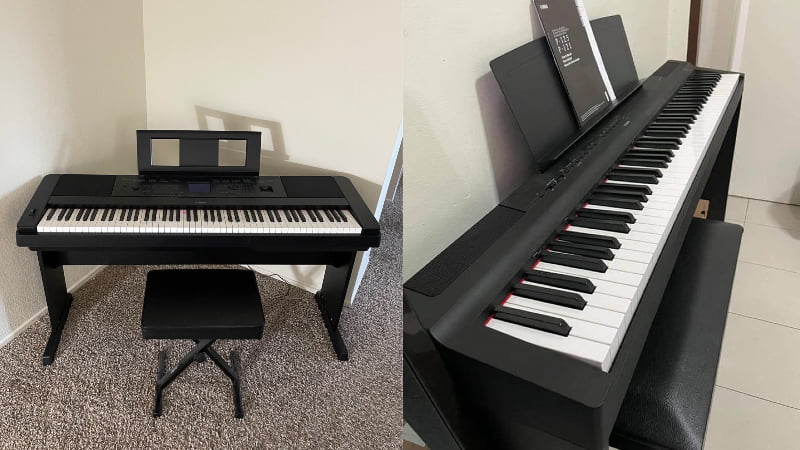When comparing these two pianos, the Yamaha DGX-660 was the obvious winner. It has better tones, more connectivity options, and it gives the player more control compared to the P125. This is about what is expected from the premium option, so if you’re willing to invest in a top-quality instrument, the Yamaha DGX-660 is worth the investment.
However, there were some features of the DGX-660 that fell short when compared to the Yamaha P125, which is a much cheaper option. Despite having a much lower price tag, the Yamaha P125 offers a whole lot of great features such as the PureCF Sound Engine and a sound system that is comparable to the more expensive DGX-660.
Since both pianos offer great features, writing this Yamaha P125 vs DGX-660 comparison was loads of fun. And while the DGX-660 offers more flexibility, the Yamaha P125 is still a good option for beginners and novice students.
Yamaha P125 vs DGX 660: Comparison Chart




Last update on 2025-07-10 / Affiliate links / Images from Amazon Product Advertising API
Yamaha P125 vs DGX-660: Differences
When directly comparing the different features of both pianos, the DGX 660 beat out the Yamaha P125 by 3-2. It was a pretty close fight, which came as a surprise, considering the price difference. While the DGX 660 offers more versatility than the P125, the P125 offers great value for the price.
Feel
The winner: Yamaha P125
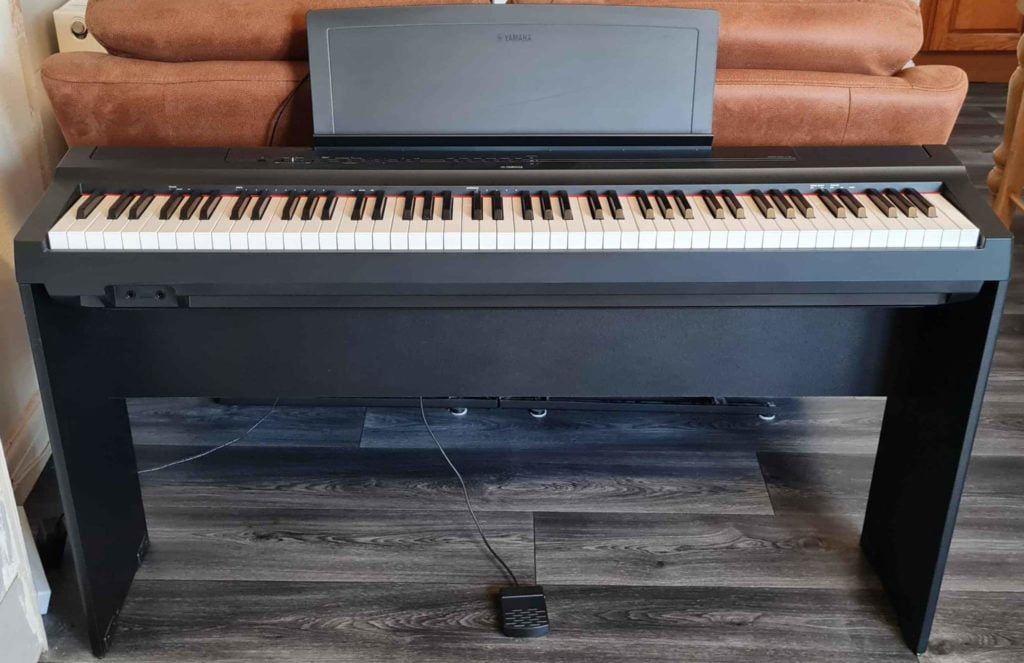
Both of these pianos have the same keys and hammer action system. And while they are exactly the same, the reason I gave the point to the Yamaha P125 in this regard is because it offers the exact same feel and playability as the DGX-660 at a much cheaper price.
Hammer Action
The Yamaha P125 and the DGX-660 use the Graded Hammer System (GHS) that is on a lot of Yamaha pianos. This is a great hammer action system that mimics the feel of an acoustic piano by having heavier keys on the left side and lighter keys on the right side. This progressive hammer action is usually a feature reserved for options in the DGX-660 price range. However, the Yamaha P125 offers the same hammer action system at a much cheaper price, which is a great thing for beginners and novices alike.
Key Texture
On both of these pianos, the key texture is a slight let down. But since the DGX-660 is a more expensive option, it’s more of a let down with this instrument. The keys on the Yamaha P125 and DGX-660 are made of plastic, and you definitely feel it. There’s no coating on the keys to give them a more realistic feel. If you’re a beginner, you may not notice the difference, but the more pianos you play, the more evident the plastic feel of the keys are on both pianos.
Tone
The winner: Yamaha DGX-660
While both pianos use the PureCF Sound Engine, the Yamaha DGX-660 offers a wider range of tones, which is the reason I chose this as the winner when it comes to tone. And as most pianists and musicians will tell you, the tone difference between the two is very evident and the Yamaha DGX-660 is the clear winner.
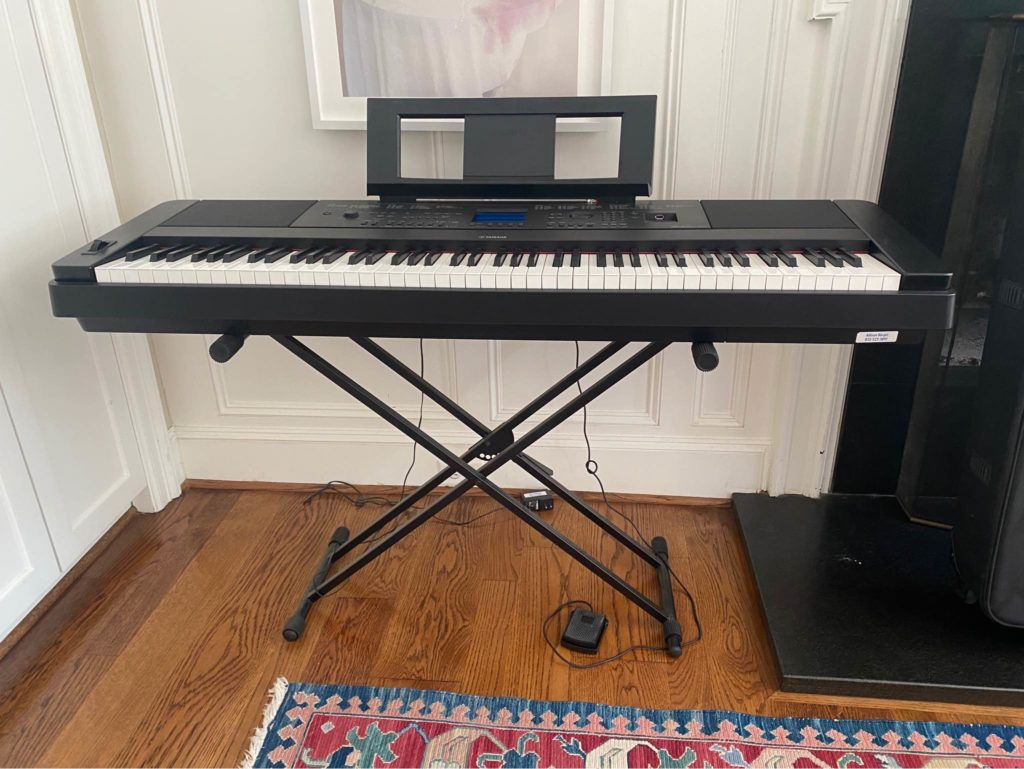
Tone Generation
The PureCF Sound Engine is a great innovation by Yamaha. While it sounds complex, it actually uses the basic tone generation model of sampling. Each piano is loaded with high-quality recordings from a wide variety of instruments, and these sounds are triggered whenever you press a key.
The PureCF Sound Engine truly shines with the piano voices of the instruments. This is because the piano samples come directly from the Yamaha CFIII grand concert piano. This is one of the brand’s most famous piano lines and is known for having a distinct bright and rich tone.
To emulate the sound of their grand pianos, Yamaha used top-of-the-line technology to record the samples and applied a digital filter to them to really bring out their unique tone. The end result is a very accurate piano tone on both instruments, which is a huge benefit for just about any pianist out there.
Sound Library
While both pianos use the same sound engineer, the reason the DGX-660 is the clear winner is the incredibly wide sound library. The Yamaha P125 only features 24 different voices. This pack includes a couple of acoustic piano tones, electric piano tones, bass, strings, and synth sounds. If you’re a beginner or novice student, this is more than enough voices to get by. All the voices are top of the line and you can use them for a wide variety of musical styles and genres.
On the other hand, the DGX-660 offers over 500 different sounds you can use in your playing. 151 of these voices use the new sound engines, including the PureCF Sound Engine. On top of that, there are 15 drums and SFX packs, including over 388 different voices from the XGlite sound pack. Admittedly, the XGlite sounds are not as clear and crisp as the other voices, however, they do provide a lot of variety and you can find tons of musical uses for the sounds.
Since the Yamaha DGX-660 is the more versatile option when it comes to the sound library, it was the clear winner over the Yamaha P125 when it comes to tone.
Piano Features
The winner: Yamaha DGX-660
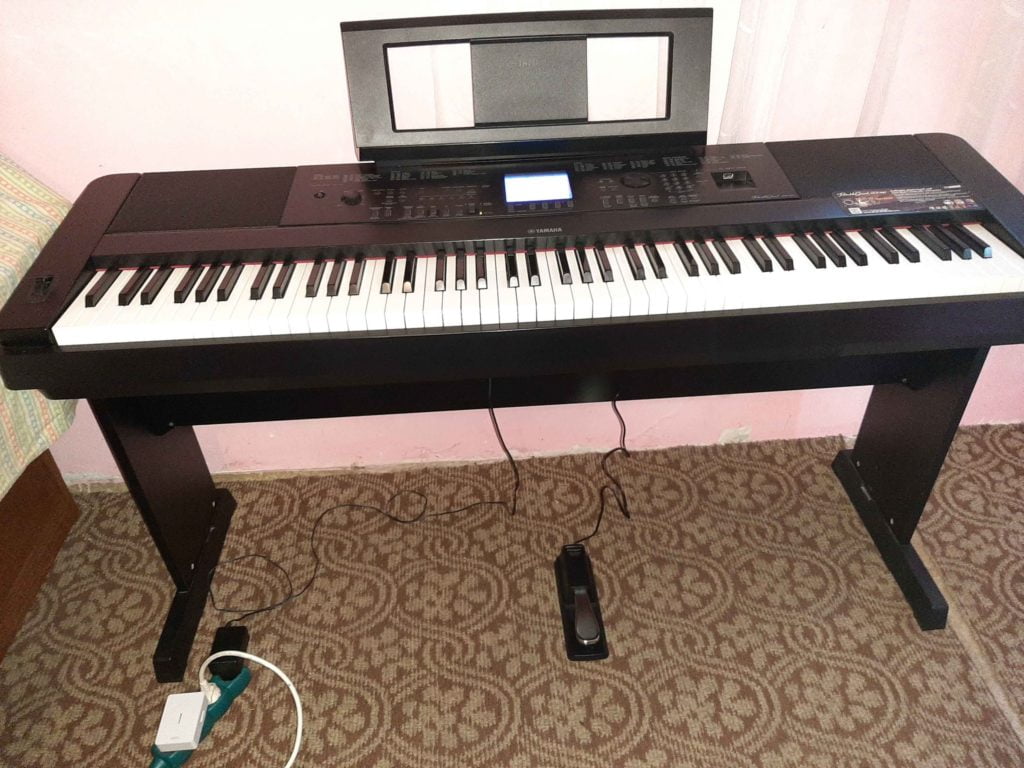
Another area where the Yamaha DGX-660 truly shines is in its piano features. The Yamaha P125 could barely compete with the competition in this regard, which is about expected from the cheaper option. With the DGX-660, you get more effects, accompaniment options, and it even comes with great playing modes that are a huge help for pianists.
Effects
The first area where the DGX-660 blows the Yamaha P125 out of the park is with its effects. Now, the Yamaha P125 comes with built-in reverb, intelligent acoustic control (IAC), damper resonance, and sound boost. If you’re a beginner and even a novice pianist, this is more than enough to have control over your tone and create a bunch of unique sounds. On top of that, the reverb on the Yamaha P125 has 4 different presets that you can use to further tweak your tone.
While the Yamaha P125 has great effects options, the DGX-660 simply has way more. On top of reverb, it comes with a chorus, IAC, and a master EQ. These effects are way more useful and practical when playing music, which is why I gave the point to the DGX-660. And if that weren’t enough, the reverb comes with 41 different presets and the chorus has 44 presets. The Yamaha DGX-660 even has DSP, which allows you to save different presets and profiles when it comes to tone, making it the much better option for serious pianists.
Accompaniment
If you’re a beginner, the Yamaha P125 has great accompaniment options. With 21 demo songs and 50 piano songs, the Yamaha P125 offers hours of fun and learning. On top of that, you can even use some of the demos and songs when performing to impress the audience. However, these songs pale in comparison to what the DGX-660 has to offer.
On the DGX-660, you have over 205 different songs to choose from. This is more than enough, even for professional musicians. And in the world of pianos and other instruments, a little extra is always better than falling short. So, in terms of accompaniment options, the DGX-660 completely blows the Yamaha P125 out of the park.
App Integration
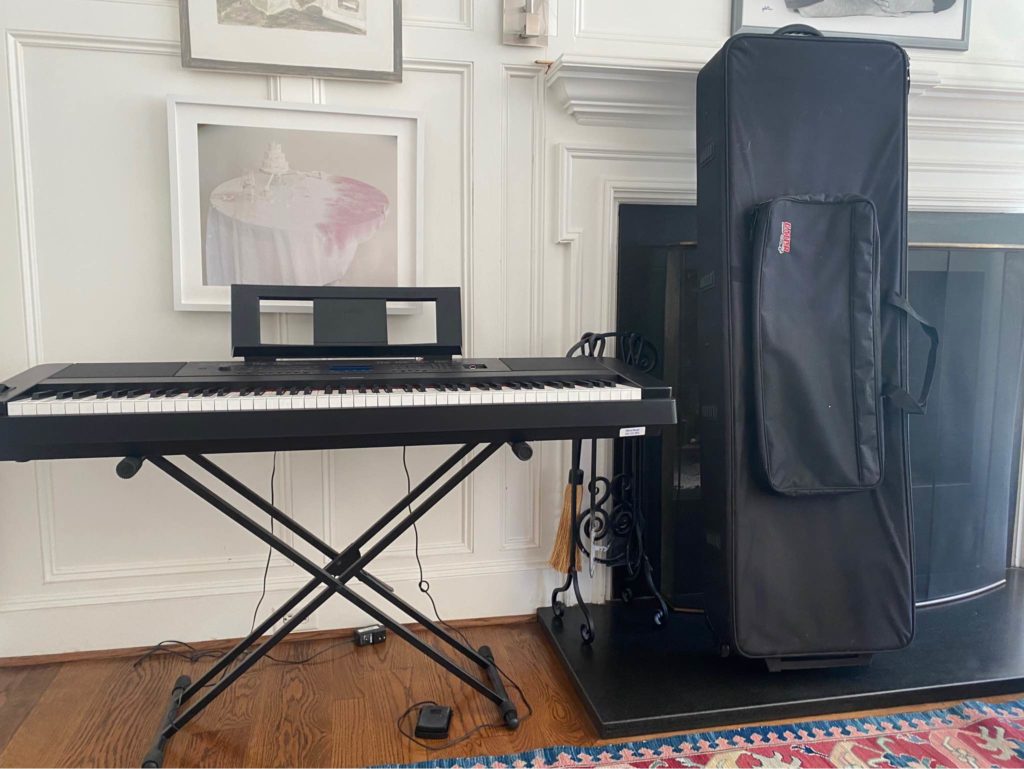
Next up is app integration. Now, this is one of the rare features where it seems that the P125 has the upper hand. You can connect the piano to your smartphone using a connector and use a bunch of different Yamaha partner apps. This includes Smart Pianist for learning and other apps you can use to tweak the sound and control different modes.
However, the reason the Yamaha DGX-660 is the winner is because it comes with the Yamaha Education Suite (Y.E.S.). Yamaha is known worldwide for great music courses as well as top-quality instruments. The YES program is no exception to this. Using this program, you can learn a wide variety of songs and techniques that are incredibly useful when learning how to become a professional pianist.
Sound System
The winner: Tie
To be honest, the built-in sound system on both pianos is a slight let down. They both have relatively small speakers which are great for jamming with a friend or practicing along. However, if you’re playing with a lot of musicians with different instruments, you’re going to need to plug in to an external sound system.
If you’re a beginner, this isn’t much of a problem. But as you get better and start playing with other musicians, you’ll find that it would be nice to have better built-in speakers. Both pianos use relatively weak speakers, on the Yamaha P125, you have two 7W speakers while you have two 6W speakers on the DGX-660. While the wattage is different with these pianos, the sound is about the same. The only reason the DGX-660 sounds a bit better from the built-in speakers is because they are loaded with better tones.
But when judging the sound systems by themselves, it’s a clear cut tie between the Yamaha P125 and Yamaha DGX-660.
Yamaha P125 vs DGX-660: The Similarities
Since both of these pianos were designed for different players, they don’t have that many similarities. The most obvious similarity would be the size. Since they are both portable, 88-key pianos with GHS, they are about the same size. With that said, the Yamaha DGX-660 is the more sophisticated option so it’s significantly heavier to accommodate all the extra features.
Another similarity between the two is the sound engine. For the grand piano sounds, both instruments use the PureCF Sound Engine, which samples the Yamaha CFIII grand concert piano. The result is a clear and crisp piano tone that is distinctly Yamaha.
But aside from what we mentioned above, these pianos are very different. If you’re a serious pianist looking for a high-performance instrument, the Yamaha DGX-660 is your best bet. With that said, since the Yamaha P125 comes with great features at a lower price, it’s an ideal piano for beginners and piano students.
Quick Rundown of the Yamaha DGX-660
- The Pure CF Sound Engine faithfully reproduces the tone of a meticulously sampled and highly acclaimed Yamaha concert grand piano
- GHS weighted action is heavier in the low register and lighter in the high, just like an acoustic piano
- Score display puts music notation of MIDI songs on the screen, helping you play your favorites by following the bouncing ball
- The Piano room lets you choose from a variety of pianos and acoustic settings to create your own personal piano environment
- The 6 track recorder allows you to capture your performances and song ideas, then add additional layers to spice up your pieces
Last update on 2025-07-10 / Affiliate links / Images from Amazon Product Advertising API
Quick Rundown of the Yamaha P125
- A fully weighted digital piano with 88 full sized piano style keys
- GHS weighted action is heavier in the low keys and lighter in the high keys, just like an acoustic piano
- The pure CF sound engine faithfully reproduces the tone of the acclaimed Yamaha 9 feet CFIIIS Concert grand piano; Tempo range: 5 to 280
- Split mode lets you play a different voice with each hand; Tuning: 414.8 440.0 to 446.8 hertz
- USB to host connectivity with MIDI and audio transfer means you only need 1 cable to connect to your music making software
Last update on 2025-07-10 / Affiliate links / Images from Amazon Product Advertising API
Product Video
Related Articles to Yamaha Dgx 660
- Yamaha YDP-164 vs DGX-660: Why You Should Go for the DGX-660
- Yamaha DGX-660 vs Roland FP-90: Why the Roland FP-90 Is the Better Pick
- Yamaha DGX-530 vs 660: Why the DGX-660 Is the Better Pick
- Yamaha DGX-505 vs 660: Why the DGX-660 Is the Better Pick
- Yamaha DGX-660 vs DGX-640: A DGX Comparison
- Yamaha DGX-660 vs DGX-630: A DGX Comparison
- Yamaha DGX-620 vs 660: Finding the Best DGX Model
- Yamaha DGX-660 vs YDP-163: Which Is the Better Piano?
- Yamaha DGX-660 vs Roland Juno DS-88: Which Is the Better Piano?
- Yamaha DGX-660 vs Casio PX-360: Which Is the Better Piano?
- Yamaha DGX-660 vs YDP-144: Which Is the Better Yamaha Piano?
- Yamaha DGX-660 vs Korg Havian 30: Which Is the Better Digital Piano?
- Yamaha DGX-660 vs Casio CGP-700: Which Is the Better Pick?
- Yamaha DGX-660 vs YPG-535: Finding the Best Yamaha Digital Piano
- Yamaha DGX-660 vs P515: Is the P515 Worth the Extra Cost?
- Yamaha DGX-660 vs P-115: Which Yamaha Model Is Better?
- Yamaha DGX-660 vs Casio PX-560: Which Piano Offers More Value For The Money
- Yamaha DGX-660 vs 650: A DGX Comparison
- Korg XE-20 vs Yamaha DGX-660: Finding the Best Digital Piano
- Yamaha P45 Vs DGX-660: A Head-to-Head Comparison
- Yamaha DGX 670 Vs 660: The Distinct Difference In Details You Need To Know About
- Yamaha YDP-103 Vs DGX-660: Which Is The Better Yamaha Piano?
- Casio PX-770 Vs Yamaha DGX-660: Should You Get A Portable Or Console Digital Piano?
- Yamaha P71 vs DGX-660: Can the Amazon Exclusive Beat Out the Premium Model?
Related Articles to Yamaha P125
- Yamaha P150 vs P125: The Battle of the P-Series Models
- Yamaha P125 vs CLP 625: Can a Beginner’s Digital Piano Match the Clavinova?
- Yamaha P125 vs Roland FP 60: Which is the Better Investment?
- Yamaha P-121 vs P-125: Finding the Best Portable Yamaha Piano
- Yamaha P125 vs Korg LP 380: Which Piano Is Better for Your Needs?
- Yamaha P125 vs P85: Can the Outdated Digital Piano Beat the Newer One?
- Yamaha P125 vs DGX 670: Which Piano Comes Out on Top?
- Yamaha P125 vs Korg SP 280: Which is the Better Beginner’s Digital Piano?
- Yamaha P-255 vs P-125: Finding the Better Option for Beginners
- Yamaha P125 vs YDP S34 Comparison: Does the Portable P125 Hold Up Against a Console Digital Piano?
- Yamaha P125 Vs YDP 164: Should You Get A Console Or Digital Piano?
- Yamaha YDP 103 Vs P125: Should You Get a Portable or Console Digital Piano?
- Yamaha P125 Vs Kawai ES110 Comparison: Which Is The Best Portable Digital Piano
- Yamaha P125 vs Casio PX S1000: Which Digital Piano Is Worth Your Money?
- Casio PX-870 Vs Yamaha P-125: Should You Get A Portable Or Console Digital Piano?
- Alesis Recital Vs Yamaha P125: Which Is The Right Pick For You?
- Yamaha P45 VS P115: Which P-Series Newbie Gives You More Value for Money?
- Alesis Recital Pro vs Yamaha P125 Comparison: Which Is The Best Portable Digital Piano?
- Alesis Prestige Artist vs Yamaha P125 Comparison: Why the Yamaha P125 Is the Better Investment
- Yamaha P125 vs Casio PX-770 Review: Why the Yamaha P125 Beats Out the Casio Console Digital Piano
- Yamaha P125 vs Roland FP-30X Review: Why the Roland FP-30X Comes Out On Top
- Yamaha P125 vs P515 Review: Why the Yamaha P515 Is the Better Investment
- Yamaha P115 vs P125 Review: Can the P125 Beat Out Its Predecessor?
- Yamaha P125 vs Roland FP30: A Close Battle Between Two Great Digital Pianos
- Yamaha P45 vs P125: Why the Yamaha P125 Is the Better Pick for Pianists
- Yamaha P71 vs P125: Why the Yamaha P125 Is the Better Investment
References:
- Yamaha DGX-660 88-key Arranger Piano with Stand – Black: https://www.sweetwater.com/store/detail/DGX660BK–yamaha-dgx-660-88-key-arranger-piano-with-stand-black
- DGX-660: https://usa.yamaha.com/products/musical_instruments/pianos/p_series/dgx-660/specs.html#product-tabs
- P-125: https://usa.yamaha.com/products/musical_instruments/pianos/p_series/p-125/specs.html#product-tabs
- Yamaha P-125 88-key Weighted Action Digital Piano – Black: https://www.sweetwater.com/store/detail/P125BK–yamaha-p-125-88-key-weighted-action-digital-piano-black
Lulacruza is an electronic folk duo operating at the junction of the hypermodern and the ancient. Our music weaves together hypnotic female singing, South American folk instruments and electronic processing, while channeling pulsating waves from the source of creation.
Lalucruza is also a community where you can connect with other music lovers to collaborate, exchange ideas and share knowledge. A platform for who wants to learns the basics of playing piano, guitar, drum masters’ technique, etc.. is the premise of our website.
